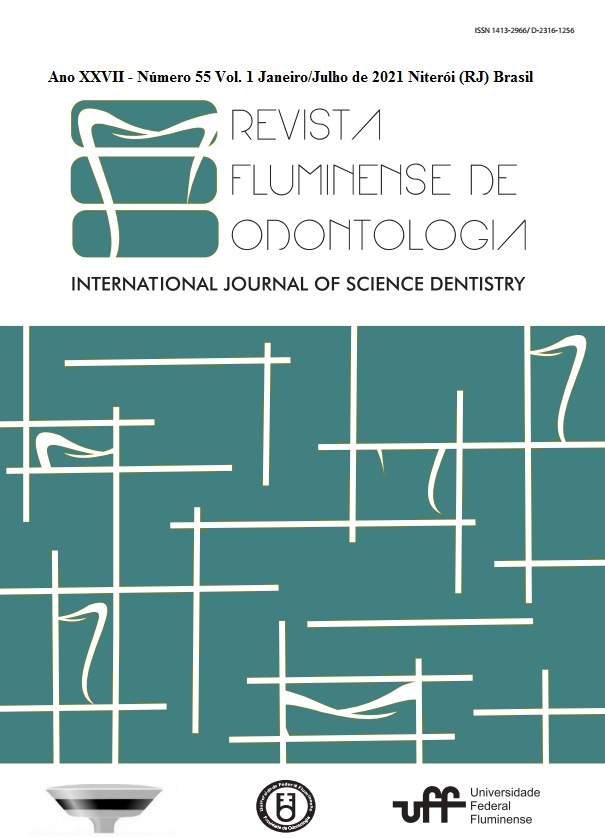CERATOCISTO ODONTOGÊNICO EM MAXILA: RELATO DE CASO CLÍNICO
DOI:
https://doi.org/10.22409/ijosd.v0i55.43140Resumo
Resumo
O Ceratocisto Odontogênico (CO)é uma lesão intraóssea benigna de origem odontogênica, que surge a partir dos restos celulares da lâmina dental; apresenta predominância de acometimento em mandíbula, principalmente com envolvimento do corpo posterior e ramo de mandíbula. Os COs podem ser encontrados em pacientes desde a infância até a velhice, todavia, mais da metade dos casos são diagnosticados em pessoas entre 10 a 40 anos de idade, sendo sua prevalência em homens. Tal lesão cística exibe ao exame radiográfico uma área radio lúcida, com margens escleróticas frequentemente bem definidas. Histologicamente manifesta revestimento epitelial composto por uma camada uniforme de epitélio escamoso estratificado, geralmente com 6 ou 8 camadas de espessura, podem ser observados ainda pequenos cistos, cordões ou ilhas satélites de epitélio odontogênico na cápsula fibrosa, a qual é tipicamente delgada e friável. O objetivo do presente trabalho é relatar o caso clínico do paciente BSM,sexo masculino, feoderma, 22 anos de idade, ASA I, que compareceu ao ambulatório de Buco-Maxilo-Facial do Hospital Federal de Ipanema/RJapresentando uma lesão cística associada ao terceiro molar superior direito incluso. O tratamento consistiu na enucleação e curetagem da lesãoem ambiente hospitalar sob anestesia geral, sem presença de intercorrências. A peça cirúrgica foi encaminhada ao Laboratório de Biotecnologia Aplicada da Universidade Federal Fluminense (LABA-UFF) para exame anatomohistopatológico, sendo confirmado seu diagnóstico inicial de CO. O paciente recebeu alta no dia seguinte ao procedimento cirúrgico e segue em acompanhamento ambulatorial de 12 meses pela especialidade, sem presença clínica e imaginológica de recidiva da lesão.
Palavras-chave: Ceratocisto Odontogênico; Enucleação; Maxila
Abstract
The Odontogenic Keratocyst (CO) is a benign intraosseous lesion of odontogenic origin, which increases from the cellular remains of the dental membrane; it presents predominance of follow-up in the mandible, mainly with involvement of the posterior body and mandible branch. OCs can be found in patients from childhood to old age, however, more than half of the cases are diagnosed in people between 10 and 40 years of age, being its prevalence in men. Such a cystic lesion is detected in the radiographic examination of a radiolucent area, with sclerotic margins often quite reduced. Histologically, the epithelial lining composed of a uniform layer of stratified stratified epithelium, with 6 or 8 layers of thickness, can also be observed in small cysts, cords or satellite islands of odontogenic epithelium in the fibrous capsule, which is typically thin and friable. The objective of the present work is to relate the clinical case of BSM patient, male, feoderma, 22 years old, ASA I, who compared the cystic lesion associated with the included dental element to the buccomaxillofacial clinic of the Federal Hospital of Ipanema / RJ. Treatment consists of enucleation and curation of lesions in the hospital environment under general anesthesia, without the presence of complications. A surgical specimen was sent to the Laboratory of Applied Biotechnology by Universidade Federal Fluminense (LABA-UFF) for anatomo-histopathological examination, confirming its initial diagnosis of OC. The patient who was discharged the day after the medical procedure and is undergoing outpatient follow-up for 12 months, with no clinical and imaginative presence of injury recurrence.
Keywords: Odontogenic Keratocyst; Enucleation; Maxilla


